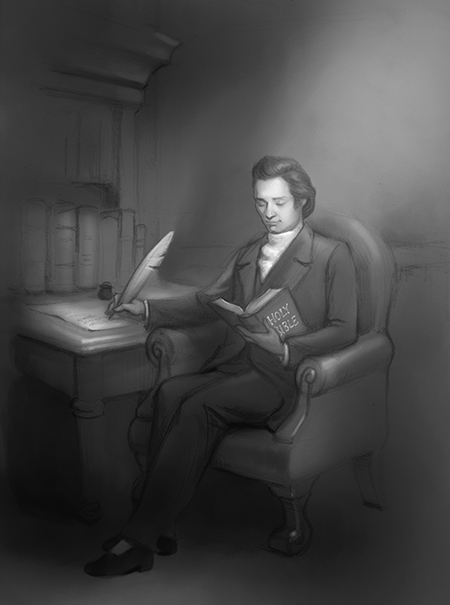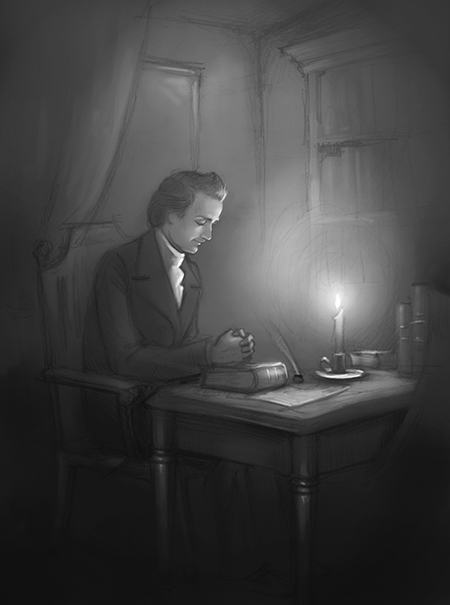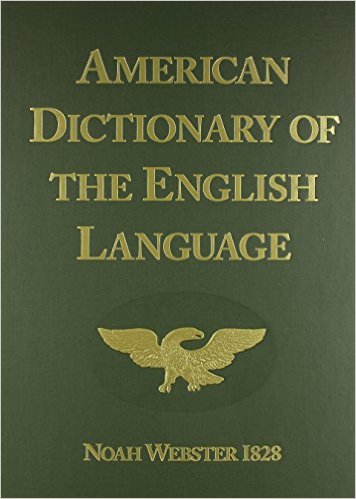|
Search, browse, and study this dictionary to learn more about the early American, Christian language. 
 1828.mshaffer.com › Word [ray]
1828.mshaffer.com › Word [ray]
RAY, n. [L. radius.] 1. a line of light, or the right line supposed to be described by a particle of light. a collection of parallel rays constitutes a beam; a collection of diverging or converging rays, a pencil.The mixed solar beam contains, 1st. calorific rays, producing heat and expansion, but not vision and color; 2d. colorific rays, producing vision and color, but not heat nor expansion; 3d. chimical rays, producing certain effects on the composition of bodies, but neither heat, expansion, vision or color; 4th. a power producing magnetism, but whether a distinct or associated power, is not determined. It seems to be associated with the violet, more than with the other rays.2. Figuratively, a beam of intellectual light.3. Light; luster.The air sharpen'd his visual ray.4. In botany, the outer part or circumference of a compound radiate flower.5. In ichthyology, a bony or cartilaginous ossicle in the fins of fishes, serving to support the membrane.6. A plant, [lolium.]7. Ray, for array. [Not in use.]Pencil of rays, a number of rays of light issuing from a point and diverging.RAY, n. A fish; a common name for the species of the genus Raia, including the skate, thornback, torpedo, stingray, &c. RAY, v.t 1. To streak; to mark with long lines.2. To foul; to beray. [Not in use.]3. To array. [Not in use.]4. To shoot forth.
|
Evolution (or devolution) of this word [ray]
| 1828 Webster | 1844 Webster | 1913 Webster |
|---|
RAY, n. [L. radius.] 1. a line of light, or the right line supposed to be described by a particle of light. a collection of parallel rays constitutes a beam; a collection of diverging or converging rays, a pencil.The mixed solar beam contains, 1st. calorific rays, producing heat and expansion, but not vision and color; 2d. colorific rays, producing vision and color, but not heat nor expansion; 3d. chimical rays, producing certain effects on the composition of bodies, but neither heat, expansion, vision or color; 4th. a power producing magnetism, but whether a distinct or associated power, is not determined. It seems to be associated with the violet, more than with the other rays.2. Figuratively, a beam of intellectual light.3. Light; luster.The air sharpen'd his visual ray.4. In botany, the outer part or circumference of a compound radiate flower.5. In ichthyology, a bony or cartilaginous ossicle in the fins of fishes, serving to support the membrane.6. A plant, [lolium.]7. Ray, for array. [Not in use.]Pencil of rays, a number of rays of light issuing from a point and diverging.RAY, n. A fish; a common name for the species of the genus Raia, including the skate, thornback, torpedo, stingray, &c. RAY, v.t 1. To streak; to mark with long lines.2. To foul; to beray. [Not in use.]3. To array. [Not in use.]4. To shoot forth. |
RAY, n.1 [Fr. raie, rayon; It. razzo, raggio, radio; Sp. and Port. rayo; from L. radius; W. rhaiz; Ir. riodh; Arm. rea, roudenn, Sans. radina. It coincides with rod and row, from shooting; extending. Hence in W. rhaiz is a spear, as well as a ray.]- A line of light, or the right line supposed to be describe by a particle of light. A collection of parallel rays constitutes a beam; a collection of diverging or converging rays, a pencil. – D. Olmsted.
The mixed solar beam contains, 1st caloric rays, producing heat and expansion, but not vision and color; 2nd. colorific rays, producing vision and color, but not heat not expansion; 3rd. chimical rays, producing certain effects on the composition of bodies, but neither heat, expansion, vision or color; 4th. a power producing magnetism, but whether a distinct or associated power, is not determined. It seems to be associated with the violet, more than with the other rays. – Silliman.
- Figuratively, a beam of intellectual light.
- Light; luster.
The air sharpen'd his visual rag. – Milton.
- In botany, the outer part or circumference of a compound radiate flower. – Martyn.
A plate of compressed parallelograms of cellular tissue, connecting the texture of the stem, and maintaining a communication between the center and the circumference.
- In ichthyology, a bony or cartilaginous ossicle in the fins of fishes, serving to support the membrane.
- A plant, [lolium.] – Ainsworth.
- Ray, for Array. [Not in use.] – Spenser. B. Jonson.
Pencil of rays, a number of rays of light issuing from a point and diverging. – Encyc.
RAY, n.2 [Fr. raie; Sp. raya; G. roche.]A fish; a common name for the species of the genus Rain, including the skate, thornback, torpedo, stingray, &c.
RAY, v.t.- To streak; to mark with long lines. – Spenser. Shak.
- To foul; to obey. [Not in use.] – Spenser.
- To array. [Not in use.]
- To shoot forth. – Thomson.
|
Ray
- To
array.
- Array; order; arrangement;
dress.
- One of a number of lines or
parts diverging from a common point or center, like the radii of a
circle; as, a star of six rays.
- To mark with long lines] to streak.
- To shine, as with
rays.
- Any
one of numerous elasmobranch fishes of the order Raiæ, including
the skates, torpedoes, sawfishes, etc.
|
| 1828 Webster | 1844 Webster | 1913 Webster |
|---|
Thank you for visiting!
- Our goal is to try and improve the quality of the digital form of this dictionary being historically true and accurate to the first American dictionary. Read more ...
- Below you will find three sketches from a talented artist and friend depicting Noah Webster at work. Please tell us what you think.
Divine Study
 
Divine Study
|
Window of Reflection
 
Window of Reflection
|
Enlightening Grace
 
Enlightening Grace
|
159
|
930 |
110
|
1016 |
184
|
1044 |

Ray RAY, noun [Latin radius.] 1. a line of light, or the right line supposed to be described by a particle of light. a collection of parallel rays constitutes a beam; a collection of diverging or converging rays, a pencil. The mixed solar beam contains, 1st. calorific rays, producing heat and expansion, but not vision and color; 2d. colorific rays, producing vision and color, but not heat nor expansion; 3d. chimical rays, producing certain effects on the composition of bodies, but neither heat, expansion, vision or color; 4th. a power producing magnetism, but whether a distinct or associated power, is not determined. It seems to be associated with the violet, more than with the other rays. 2. Figuratively, a beam of intellectual light. 3. Light; luster. The air sharpen'd his visual ray 4. In botany, the outer part or circumference of a compound radiate flower. 5. In ichthyology, a bony or cartilaginous ossicle in the fins of fishes, serving to support the membrane. 6. A plant, [lolium.] 7. ray for array. [Not in use.] Pencil of rays, a number of rays of light issuing from a point and diverging. RAY, noun A fish; a common name for the species of the genus Raia, including the skate, thornback, torpedo, stingray, etc. RAY, verb intransitive 1. To streak; to mark with long lines. 2. To foul; to beray. [Not in use.] 3. To array. [Not in use.] 4. To shoot forth. |

|
| Hard-cover Edition |
366 |
 |
537 |
|
| Compact Edition |
350 |
 |
241 |
|
| CD-ROM |
302 |
 |
192 |
|
* As a note, I have purchased each of these products. In fact, as we have been developing the Project:: 1828 Reprint, I have purchased several of the bulky hard-cover dictionaries. My opinion is that the 2000-page hard-cover edition is the only good viable solution at this time. The compact edition was a bit disappointing and the CD-ROM as well. |
| [ + ] |
| Add Search To Your Site |
|
|
|
 1828.mshaffer.com › Word [ray]
1828.mshaffer.com › Word [ray]
